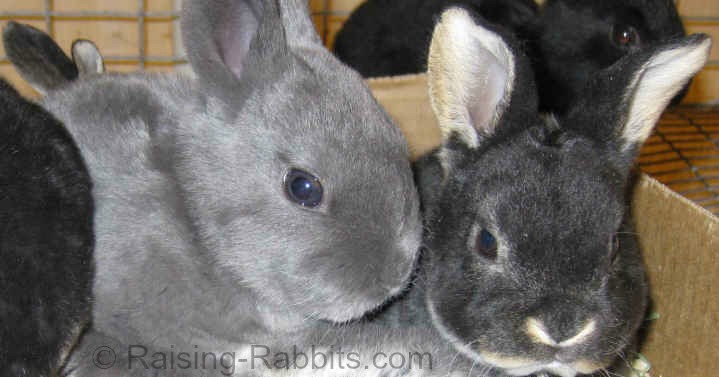Rabbit Rhythms of January
"My Doe Rabbit with an Unplanned Pregnancy"
 Well, the rabbit’s pregnancy was not exactly ‘unplanned,’ because the New Zealand White doe had been purposefully bred. Twice. And therein lay the problem.
Well, the rabbit’s pregnancy was not exactly ‘unplanned,’ because the New Zealand White doe had been purposefully bred. Twice. And therein lay the problem.
Here’s the owner of the doe telling his story: My Unplanned Pregnant Doe Rabbit. (Right: Picture provided to Raising-Rabbits with the story.)
Mr. Reid apparently bred the doe, and then test-bred her on day 14. He then marked both dates on the calendar.
So far, so good. As the first date neared, he eyeballed the doe’s belly, and didn’t see much difference. So, not trusting his ability to palpate her belly, he assumed she must not be pregnant because she didn’t look pregnant to him. Oops!
Some does hide their pregnancies very well, especially a meat rabbit with just 4 babies.
I’m very happy that things worked out okay for Mr. Reid. The bunnies were born in Jamaica last July, right on schedule for the first set of dates. Warm mid-summertime temperatures of around 90 degrees F probably saved the lives of the kits. With a warm ambient temperature, the kits are more likely to survive in a less-than-perfect nest.
The fact of the matter is: mixing up our dates can happen in any season of the year. Since it is now January, it becomes very important to keep careful records. In snowy parts of the country, if your doe kindles without an adequate nest, you’ll find frozen baby kitcicles in the morning.
Mr. Reid’s story teaches us a few things:
- Does don’t always show their pregnancies.
- It is better to not test-breed, but if you do, give your doe a nest box on day 28 from the FIRST breeding even if she doesn't look
pregnant. Failing a kindling, give her a new nest (or refresh the first one) on day 28 of the SECOND breeding.
- Learning how to palpate the doe's abdomen is a good thing. It is easy, but it usually takes practice. Palpating doesn’t require a lot of pressure. Try palpating a buck to learn what the guts feel like with no babies, and then it might be easier to recognize the indiscreet lumps that are the growing fetuses.
- Mr. Reid did a good job salvaging a surprising situation. Thank you for sharing!
Visit our Pregnant Rabbit page for more tips, including how to palpate.
Raising-Rabbits.com
Content is Copyrighted
No one, including Raising-Rabbits.com, can copyright a topic or an idea. But the WAY we discuss topics or ideas (our phrases and photos) on Raising-Rabbits is copyrighted - © www.Raising-Rabbits.com - All Rights Reserved. You'll find this copyright notice at the bottom of every page.
Six weeks ago we ran a scan of the entire internet through our Plagiarism Service. As a result, we’ve been spending the last 6 weeks sending copyright infringement notices to a fairly amazing number of websites. And we’re not done yet.
On one hand, I suppose we should be flattered. On the other hand, plagiarism is stealing, which makes the search engines very unhappy.
What does that look like? Copying and pasting word for word the entire contents, or a sizeable chunk, of a web page. It also includes taking the content, swapping out a word here and there, and then claiming it is your original work.
I’m grateful that the responses to our notices have been
for the most part immediate and very cooperative. For these sites, there are no hard feelings on our part.
How to use and share material from Raising-Rabbits.com:
Current copyright laws DO allow others to use the title of a page, give correct attribution (byline), quote up to 4-5 lines of the copyrighted text if you think you need to, and provide a link back to the original page.
If you wanted to share information from our "Sexing Rabbits" page, for example, here’s an example of what that might look like:
{Example}
Sexing Rabbits, by (or from) Raising-Rabbits.com,
Sexing rabbits can be subject to operator error. The likely cause of the misidentification of a rabbit’s gender is simply not knowing exactly how to sex a rabbit.
It is not hard to tell male from female, but it is easy to make a mistake if you don’t examine the bunnies carefully ... If you don’t apply enough pressure on the
vent area for fear of hurting the bunny, nothing will protrude at all.
Read more and see the photos at https://www.raising-rabbits.com/sexing-rabbits.html.
{End Example}
There, that’s easy! This is a snippet in which you’ve given credit to the original source, and also provided a service for anyone you know who needs to figure out whether their rabbits are male or female.
Were you hoping to provide your own material about sexing rabbits? Great! In that case, you get to write your own words and take your own photos.
Any questions about permissions? Just ask at Contact Us. We’ll get back to you just as soon as possible.

(Note the copyright notice in the picture above.)
Rabbits in the News
Times they have a-changed!
Eighty-five years ago, it was well understood that rabbits could wreak destruction on the inside of your home, chewing baseboards, furniture and whatever electrical cords might be found in a home cerca the 1930s. Housing agreements in the UK back in the day prohibited house rabbits, pigeons and fowl inside houses as a way to protect the dwelling from loss of value. This information was found recently in a very old tenancy agreement form; here's the news story: 80 year old tenancy agreement found. (2018 update: this news story is apparently no longer available.)
On the other side of the spectrum:
Today in Dublin Ireland, as in the USA, pressure is being applied for people to adopt rescue rabbits and to turn them into - you guessed it - house rabbits. Not one word is mentioned by representatives of the Dublin SPCA in this news article about the propensity of rabbits to chew anything they can get their chisels on.
Oh but, "They can use litter trays like a cat." Yes, they can be trained to use litter trays. But a cat, once trained, will use the litter tray every time. A rabbit, on the other hand, will use the litter tray only if it is convenient to the rabbit.
With this type of selective reporting, we strongly encourage you not to feel guilted into ‘rescuing’ an animal, especially a rabbit. But if you’d like to do so, be sure you obtain one that is healthy, and not aggressive, mean, or buck-toothed. It’s just not worth the bites or the vet bills for a sick rabbit.
See our Rabbits for Sale page for extra tips on finding an excellent rabbit as a pet or for other utilitarian purposes.
Like this newsletter?
Maybe your friends would too...
Your friends at Raising-Rabbits.com wish you a wonderful New Year season and January 2013.
Enjoy your rabbits!
|

 Well, the rabbit’s pregnancy was not exactly ‘unplanned,’ because the New Zealand White doe had been purposefully bred. Twice. And therein lay the problem.
Well, the rabbit’s pregnancy was not exactly ‘unplanned,’ because the New Zealand White doe had been purposefully bred. Twice. And therein lay the problem.
